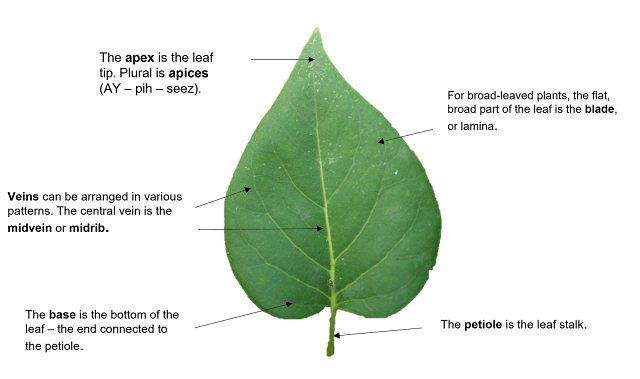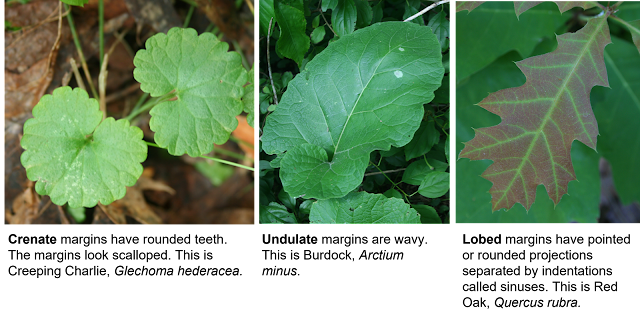The last two posts introduced leaf arrangement and leaf divisions, two features used in many guides to help identify plants. This post goes deeper into the weeds to introduce leaf morphology – the shape and structure of leaf blades, stalks and edges.
Leaves are tremendously variable in shape and structure, so
there are many terms to describe them. It’s impractical – and overwhelming – to
cover all of them here, so this post introduces only those that are commonly used in technical keys. To learn
more, see the resources at the end of the post.
Leaf parts
Before diving into morphology, it’s helpful to know the names of leaf parts. They are marked below on the simple leaf of Common Lilac, Syringa vulgaris. Most of the terms also apply to the leaflets of a compound leaf. (See the previous post for a tutorial on simple and compound leaves.)
Leaf apices
Dozens of terms describe leaf apices, but four are especially common: acute, acuminate, mucronate and obtuse.
Leaf bases
Leaf bases are also diverse. Common terms for their shapes are acute, obtuse, oblique, cordate, truncate and sagittate.
Leaf margins
Leaf margins that are continuous – not toothed, notched or lobed– are called entire. Margins that aren’t entire are variously shaped and have several terms to describe them, including dentate, serrate, crenate, undulate and lobed.
Leaf surfaces
Leaves are surprisingly diverse in surface texture. If the surfaces are smooth, they’re called glabrous. If they have a white or bluish, waxy coating that can be rubbed off, they’re glaucous. Hairy leaves have many terms to describe them, but a common overall term is pubescent.
Leaf attachments
Petiolate leaves are attached to a stem with a petiole, or leaf stalk. Sessile leaves lack petioles; they are unstalked and attached directly to the stems. Perfoliate leaves wrap around and are pierced by the stem. Clasping leaves, as the name implies, clasp the stem with the base of the leaf. Sheathing leaves wrap around the stem and extend down its length to form a sheath.
Stipules
Stipules are pairs of leaf-like or thread-like appendages at the base of the petioles of some leaves. Not all species have them, but if stipules are present, their size and shape are useful for identification.
Leaf shapes
This is where terminology really takes off. Because leaves come in a wide variety of shapes, there are many words to describe them. Common terms are cordate, deltoid, elliptic, lanceolate, oblong and ovate.
Adding “ob” to the beginning of cordate, lanceolate or ovate means the shape is reversed. An obcordate leaf, for example, looks upside down compared to a cordate leaf.
Expect inconsistency, intermediates and combinations
Leaves are variable even on the same plant. In the folowing photo of
Japanese Lilac, Syringa reticulata, the bases of older leaves look truncate or obtuse,
whereas the bases of younger leaves look acute. It’s best to look at several leaves
to get a sense of what’s typical.
In some cases, leaves look intermediate between two morphologies. It’s common to find combination terms for their shapes, like ovate-elliptic or lanceolate-ovate. For example, the leaves of Swamp Milkweed, Asclepias incarnata, below, are described as oblong-lanceolate or lanceolate, with an acute to acuminate apex.
Test your knowledge
Here’s a description that could be found in a technical guide:
Leaves petiolate, lobed, margins coarsely serrate to dentate, blades glabrous, base
broadly cordate, apex acute to acuminate. Which of these leaves best matches
this description? Scroll down for the answer.
More resources
Plant Identification Terminology: An Illustrated Glossary,
by James G. Harris and Melinda Woolf Harris. Second Edition. Spring Lake Publishing,
Spring Lake, Utah, 2001. 206 pp.
Botany
Primer: Understanding Botany for Nature’s Notebook. This public-domain
primer from the USA National Phenology Network covers many aspects of botany,
including leaf morphology. The full citation for this reference is:
Guertin, P., Barnett, L., Denny,
E.G., Schaffer, S.N. 2015. USA National Phenology Network Botany Primer.
USA-NPN Education and Engagement Series 2015-001. www.usanpn.org.
Biology and botany textbooks also cover plant morphology. School and public libraries may have some on their shelves. Another choice is LibreTexts™, a non-profit collaboration that offers free online access to postsecondary textbooks. At the website, open the Explore the Libraries menu and choose Biology. Then choose Bookshelves and look for Botany.
References
(1) Minnesota Wildflowers: A Field Guide to the Flora of Minnesota. Maintained by Katy Chayka. Accessed March 12, 2022.
(2) Minnesota Biodiversity Atlas. University of Minnesota, Bell Museum. Accessed March 12, 2022.




















